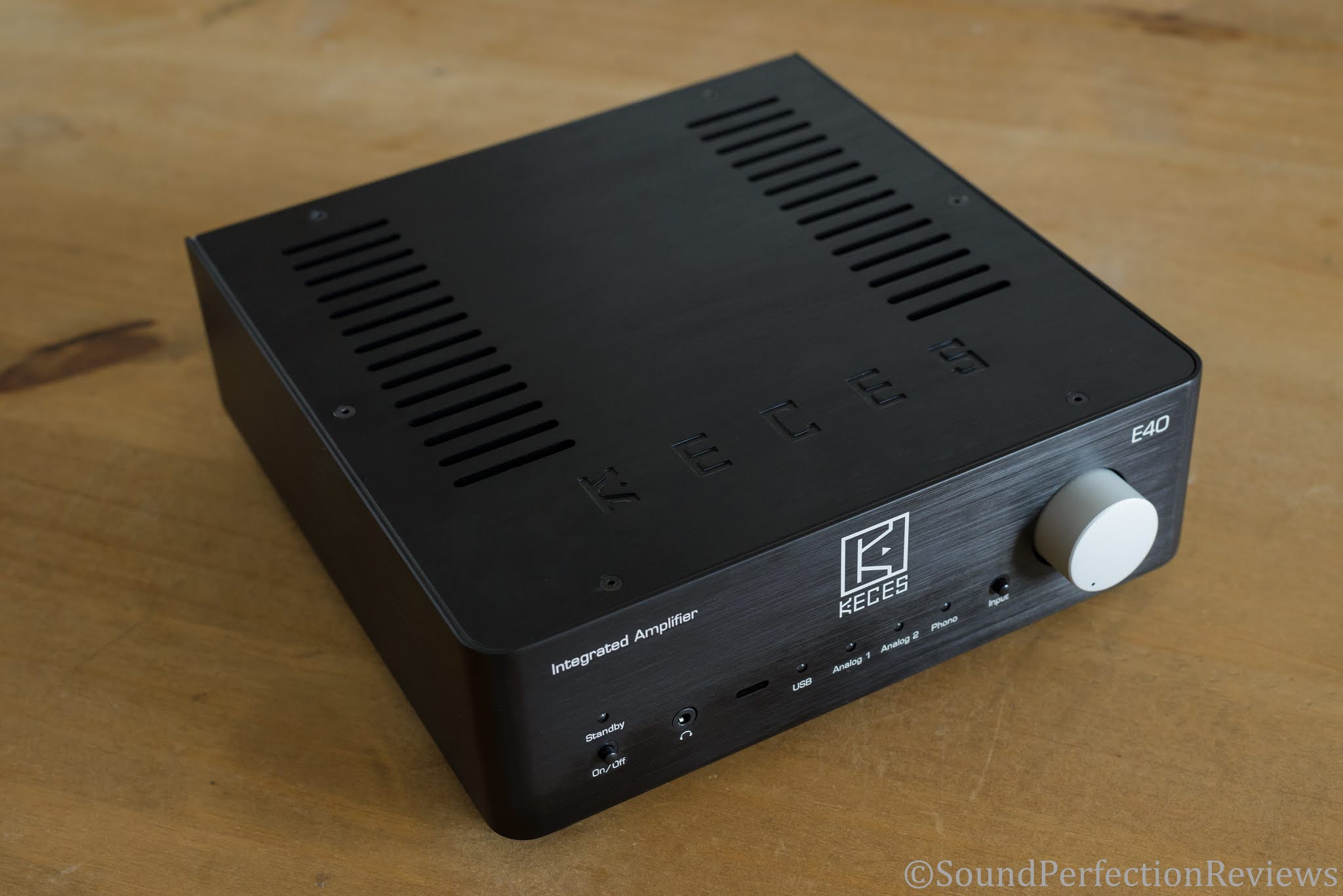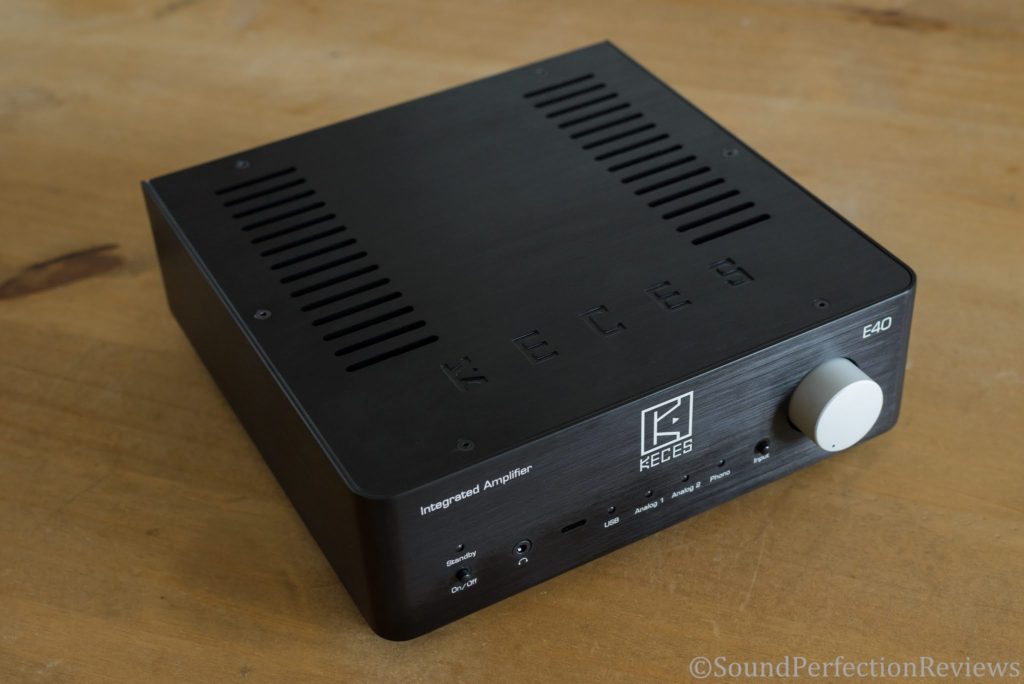Firstly I would like to thank Arthur at Keces USA for the support in arranging this sample for review.
*disclaimer: This sample was provided for the purpose of writing a review, no incentive was given to write a favourable review. All opinions expressed are my own subjective findings

Tech Specs:
• Power Output: 50W x2 @ 8ohm / 65W x2 @ 4ohm
• Power Bandwidth: 5Hz – 100kHz
• Total Harmonic Distortion (THD+N): <0.008% at 1kHz A-Weighting
• Total Harmonic Distortion (THD+N): for Phono MM <0.02% at 1kHz A-Weighting
• S/N R: 110dB A-Weighting
• S/N R: for Phono MM 82dB A-Weighting
• Digital to Analog Converter: Supports PCM up to 48kHz/16-bit
• AC Input Voltage: 110V-120V, 60Hz / 220V-240V, 50Hz (User switchable)
• Power Consumption: 180 Watts
• Casing: 3mm Aluminum
• Dimension: (WxDxH) 220x220x66mm
• Weight: 4KG
• MSRP: $599.95
Packaging, Build quality and Accessories:
The E40 comes in quite a plain cardboard box, much like most hifi components. The box is tough though, and provides plenty of protection during shipping, so that is a relief. Inside you get nice foam inserts holding the amp tightly in place, along with a section for the power cable. Overall simple but strong packaging that is easy to open yet provides excellent protection during shipping.
The E40 is built like all the other Keces products, out of solid aluminium with a sturdier and more industrial look. Everything is extremely well put together with no gaps or faults to be found. The sockets are tight, the binding posts strong and I cannot fault a single part of the build of the E40. The E40 really is built like a tank.
Accessory wise you get a user manual and a small remote, to be fair there isn’t really anything else you need for an integrated amplifier.
Features:
Being an integrated amp, the E40 has a few input options along with other features. On the front you have a headphone socket, but it is a 3.5mm socket and not the more common 6.3mm found on larger amps, luckily Keces have built in a great headphone amp circuit but it isn’t the most powerful in the world. You also have the silver volume knob on the front, along with the power button and input select button. On the back you have the binding posts for your speakers, they accept bare wire, spades and 4mm banana plugs. Input wise you get 2 regular RCA line-inputs, a USB input and also a phono input as the E40 has a built-in phono pre-amp. You get an RCA pre-amp output too for running in to a sub-woofer should you have one in your system.
The remote is simple and you can power the amp on/off with it, along with changing input, volume up/down and muting. The remote works well, however out of the box the volume knob can sometimes stick a little when remotely controlling the volume, this does get better the more you use the amp.
Sound:
I have been using the Keces S3 with their S125 for a while, and was keen to see what their lower priced integrated amp could do. So, I hooked it up to my Bowers & Wilkins 606’s and off I went, I used the internal DAC and phono pre-amp to test those too.
Upon first listen I was incredibly surprised at how big the sound was from this tiny little integrated amp; it really packs some punch and has no issue driving the 606’s or similar spec speakers. I found the S3 / S125 combo to be a little too clean at times, and the sound could sometimes be a little on the fatiguing side (with the 606’s), the E40 came in and added a little life into the sound. The E40 isn’t what I would call coloured though, the lows are still tight and clean but they seem to be a little fuller and more engaging. The midrange is still open and airy, with excellent detail. There is excellent linearity to the whole sound, allowing the treble to sparkle and extend without any issue. There is great coherency and placement of the instruments within the soundstage, with a well focused center image. The E40 never sounds strained when it comes to extension on each end either.
Compared to the S3/S125 combo, the E40 is a little more fun and just enjoyable to listen to, the S3/S125 are technically better and you can hear that they are more detailed, have better resolution and are tighter sounding. The E40 however manages to be more engaging and yet has none of the slight veil/grain that lower amps tend to have.
The internal DAC is perfectly acceptable for casual use, it is neutral and linear but limited in terms of the bit rate it can handle, an external DAC is still going to be a bit better. The internal phono-amp on the other hand is excellent with a really low noise floor and no noticeable colouration, no need to upgrade unless you are using a high end turntable.
As has been my experience with previous Keces equipment, the E40 is quite linear and exceptionally well controlled when it comes to timing and responsiveness, however it is not clinical. Perhaps it is not quite as tight sounding as the S125 which has a lot more power behind it, but you get a little more fun out of the E40 which works better with neutral to slightly bright speakers. Keces may not have the heritage of some of the older British or Japanese audio companies, but from their releases so far, they are a brand to keep an eye on.
Conclusion:
The E40 is yet another excellent product from Keces, they know what they are doing when it comes to creating a great sounding yet modestly priced amplifier. The small chassis may look a bit plain and industrial, but the sound that comes out of it is huge, with a natural yet punchy delivery of your favourite music. It may not have many digital inputs (only USB), or a huge amount of analogue inputs, it may not have fancy tone controls, but it delivers pure Class AB power that just gets out of the way and allows you to sit back and enjoy the music. What it lacks in features and connectivity it makes up for in sound quality and space saving.
Sound Perfection Rating: 9/10 (internal DAC is limited, but for the price and size this amp is superb)




This is about the same price range as a Cambridge Audio CXA60 which is praised by many HiFi review sites. If you had the chance to listen to it. How how would you say it compares ?
I'll try and listen to the CXA60 at some point, but it'll be a demo so I won't have my own equipment. The CXA60 has a few more inputs as it is larger, but I'm not too sure it'll sound better. The keces is really superb for the price.
I’m retired and on a modest fixed income. Overtime I’ve managed to put together a sweet little system. One that I’m quite happy with that includes my KECES E40. An Asus i7 MiniPC running Roon/Qobuz outputs over ethernet cable to a Matrix Audio Mini-i Pro 3 Streamer DAC, which connects to the KECES E40. The amp & streamer sit on a wooden surfaced table with rigid strong metal legs. Equipment is fully isolated from each other and the table’s surface with Herbie’s Audio Labs proprietary platinum-silicone ‘soft dots’. Connected to the Amp are a pair of Elac Carina BS243.4 bookshelf speakers on their dedicated stands along with a QUAD LF-66 Subwoofer. That sub has a dipole arrangement with twin opposed 6.25 inch drivers, which roughly equals the area of a nine inch driver. It goes cleanly down to 35Hz, which is sufficient for me. The sub sits directly beneath the open sided table, so bass frequencies are unhindered from obstruction. A solid system in a 182 sq. ft. room. The mint condition Matrix Audio Streamer DAC was bought used. Everything else was bought new on sale at a solid discount. My theory of audio equipment is to buy well made equipment that punches at least a bit above its weight. Recognizing that manufacturers have to construct to a price point and then, unless dealing with price no object equipment… corners will be cut. That’s where accessories and tweaks can come into play.
Planned future purchases; SignalCable power cords, a better quality fuse for the E40, an iFi AC iPurifier, iFi LAN iSILENCER ETHERNET NOISE FILTER, EVS Music Purifiers & Ground Enhancers and Bybee QSE ‘plates’. Some of these I already have successfully working in my ‘analog’ system. In general, I try to buy from reputable dealers with a return policy, if a tweak/accessory doesn’t work in my system, I simply send it back.